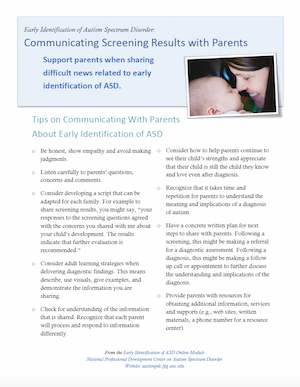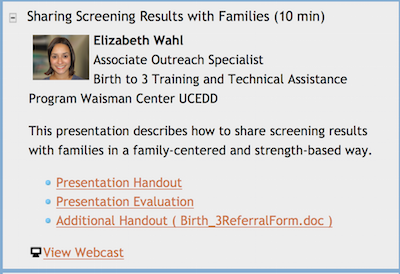Surveillance, Screening, and Diagnosis for Early Identification of ASD
Surveillance, Screening, and Diagnosis for Early Identification of ASD
There is considerable need for further research, innovation, and improvement in early identification, given the gap between the age when ASD characteristics are first noticed and when a diagnosis is made, as Shattuck et al. (2009) suggested. There are several levels of recommended practices that lead to the early identification of ASD.
Surveillance is the ongoing process of identifying children at risk. Surveillance methods are often simply questions that primary care providers ask all parents at well-child visits about developmental milestones.
Screening is a brief assessment that uses standardized instruments to identify children at significant risk of having a disorder. The results of screening indicate the presence of risk characteristics for delay or disability, but do not provide a diagnosis.
Diagnostic assessment involves a detailed assessment process using standardized tools, observations, and clinical history to define the child’s difficulties and determine the presence of a clinical diagnosis. A diagnostic assessment is the final step in early identification of a specific disorder.
The American Academy of Pediatrics endorsed new practice parameters for ASD screening and evaluation to occur with primary care pediatric practices as summarized in Identification and Evaluation of Children with Autism Spectrum Disorder (Johnson et al., 2007).
Download PDF: http://pediatrics.aappublications.org/content/120/5/1183.full.pdf
There are several new early identification guidelines laid out in this document, which represents a significant new milestone for the autism field.
Among the most important recommendations are the following:
Primary care providers should become aware of early signs of ASD;
Primary care providers should routinely ask all parents about developmental milestones and behavior at each visit; If any concerns are identified by parents or professionals, an autism-specific screener should be administered and/or the child should be immediately referred for a diagnostic evaluation, depending upon the level of concern;
Primary care providers should screen all children, using an autism-specific screener, at 18 and 24 months of age.
These autism specific refinements follow previously established parameters for the universal screening of all children for potential developmental delays at 9, 18 and 24 (or 30) months during well-child visits. This surveillance and screening algorithm can be found at the National Center for Medical Home Implementation website.
Continue for more information on Surveillance, Screening, and Diagnostic Assessments
Communicating Screening and Diagnostic Results with Parents
Communication of findings to parents is an essential part of early identification and diagnosis of ASD.
Parents are often the first to recognize that something is different in their child’s development. By the time surveillance and screening is conducted, some parents may have already had concerns about their child’s development. It is important to consider a parent’s perceptions when discussing with them your developmental concerns and questions about red flags for ASD. The direction of a conversation might progress differently with a parent who has already been wondering if their child is showing characteristics of ASD compared to a parent who has not considered the possibility.
If you are a professional, for a parent with questions about their child’s development, start a conversation with recognition of the concerns followed by queries for more detailed descriptions. If a physician, child care provider, or other family member first notices the concerns, the conversation would start differently.
The conversation might start with a statement of concern, such as, “I’ve noticed that your child isn’t showing an interest in what you are experiencing together. Have you noticed this?”
Allow for exchanges with families within context of conversations
These scenarios create a context for those conversations that provide exchanges with families, rather than reporting to families, within which a diagnosis of ASD is delivered.
Choose language carefully
It is important to choose language carefully and give a clear message about the findings. If further evaluation is recommended due to concerning screening results, say so. If a diagnostic assessment indicates the diagnosis of autism, say so. Concurrently, if a screening or diagnostic assessment indicates no concerns, it is equally important to assure parents that their child’s development is on track with typical development or to highlight concerns for future follow up.
Be prepared for parents' emotional responses
Parents will have a range of emotional responses to new developmental or diagnostic information about their child.

Support parents when sharing difficult news related to early identification of ASD.
View Tips on Communicating Screening Results with Parents
For more guidance, view this video webcast form the Wisconsin Medical Home Webcast Series.
Sharing Screening Results with Families
Website URL: http://www.waisman.wisc.edu/connections/webcast.php

